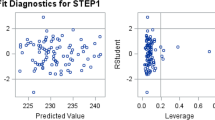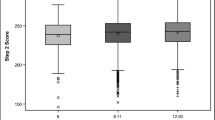Abstract
Proper interpretation of the results of the United States Medical Licensing Exam (USMLE) is important for program directors, residents, and faculty who advise applicants about applying for residency positions. We suspected that applicants often misinterpreted their performance in relationship to others who took the same examination. In 2005, 54 consecutive applicants to the University of Tennessee, College of Medicine internal medicine residency program were asked to complete a brief survey about their performance on Parts 1 and 2 of the USMLE exam. When asked what percentile their Part I score represented, slightly over one in ten were unsure or did not know, and nearly three out of five wrote in their two-digit score. Of the 15 who wrote in another number, only a third were within ten percentile points of their estimated percentile. Similar results were seen for Part II. A higher percentage of international medical graduates (IMGs) than U.S. applicants responded to the percentile question with their two-digit scores (79% vs. 50% p = .08). Applicants to residency programs frequently misinterpret their performance on the USMLE compared to their peers. Unless they are high performers, those who misinterpret their two-digit scores as percentiles markedly overestimate their performance. The sponsors of the USMLE should discontinue reporting the two-digit score and consider re-instating the reporting of percentiles.

Similar content being viewed by others
References
Andriole, D. A., Jeffe, D. B., Hageman, H. L., & Whelan, A. J. (2005). What predicts USMLE Step 3 performance? Academic Medicine, 80, S21–S24.
Berner, E. S., Brooks, C. M., & Erdmann, J. B. (1993). Use of the USMLE to select residents. Academic Medicine, 68, 753–759.
Bowles, L. T., Melnick, D. E., Nungester, R. J., Golden, G. S., Swanson, D. B., Case, S. M., et al. (2000). Review of the score-reporting policy for the United States Medical Licensing Exam. Academic Medicine, 75, 426–431.
Durning, S. J., Pangaro, L. N., Lawrence, L. L., Waechter, D., McManigle, J., & Jackson, J. L. (2005). The feasibility, reliability, and validity of a program director’s (supervisor’s) evaluation form for medical school graduates. Academic Medicine, 80, 964–968.
O’Donnell, M. J., Obenshain, S. S., & Erdmann, J. B. (1993). Background essential to the proper use of the results of Step One and Step Two of the USMLE. Academic Medicine, 68, 734–739.
Paolo, A. M., & Bonaminio, G. A. (2003). Measuring outcomes of undergraduate medical education: Residency directors’ ratings of first-year residents. Academic Medicine, 78, 90–95.
United States Medical Licensing Examination. (n.d.). Retrieved July 26, 2006, from: http://www.usmle.org
Acknowledgements
The authors wish to acknowledge the valuable assistance of Mr. Benjamin Moffitt, Department of Medicine Research Associate, in the conduct of this project.
Author information
Authors and Affiliations
Corresponding author
Appendix
Appendix
Study questionnaire
We are performing a study to better understand how applicants interpret their USMLE scores.
In answering these questions, please consider that a percentile is a unit used to describe a portion of the individuals or events being studied. Suppose the data are arranged by numerical scores, from highest to lowest. A score belongs to the 78th percentile, for example, if it is greater than 78% of the scores but is not greater than 79% of the scores. This procedure divides the scores into 100 percentiles, numbered 0–99th.
Please answer the following:
What was your USMLE Part I score? ______
What percentile does this represent? ______
What was your USMLE Part II score? ______
What percentile does this represent? ______
Rights and permissions
About this article
Cite this article
Jones, R.C., Desbiens, N.A. Residency applicants misinterpret their United States Medical Licensing Exam Scores. Adv in Health Sci Educ 14, 5–10 (2009). https://doi.org/10.1007/s10459-007-9084-0
Received:
Accepted:
Published:
Issue Date:
DOI: https://doi.org/10.1007/s10459-007-9084-0




